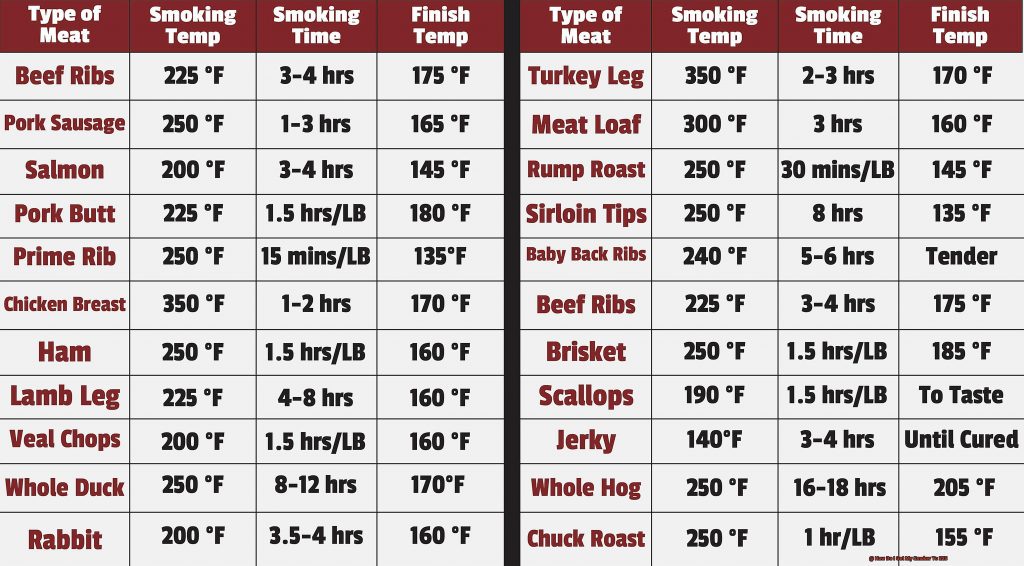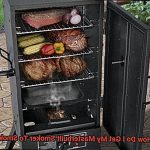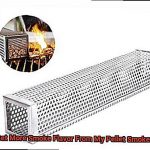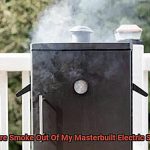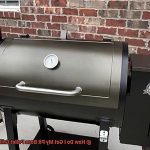Well, then you know the secret to mouthwatering smoked goodness lies in getting your smoker to that perfect temperature of 225 degrees Fahrenheit. Whether you’re craving some fall-off-the-bone ribs or a juicy brisket, nailing that magical temperature is the key to unlocking flavor heaven. Lucky for you, I’ve got all the tips and tricks to guide you through this smoking hot journey.
First things first, let’s talk fuel. Whether it’s charcoal, hardwood, or pellets, make sure you’ve got enough to keep that fire burning throughout your entire smoking session. And before you get started, clear out any ash or debris from previous smokes. You want a fresh start for that tasty meat masterpiece. Now arrange your fuel in a way that encourages proper airflow – think of it as creating the perfect cozy nest for your fire. If you’re using charcoal, consider using a chimney starter for an even ignition.
Once your setup is ready, it’s time to light up that fire. Use a few lit charcoal briquettes or grab yourself a propane torch to kickstart the flames. Take it easy though; Rome wasn’t built in a day and neither is great BBQ. Slowly add more fuel as needed to maintain that steady 225-degree temperature we’re aiming for. Remember, patience is not just a virtue here; it’s the secret ingredient.
Now let’s talk about airflow control – the Jedi skill of maintaining consistent temperatures. Adjust those dampers and vents like a boss. Start by opening them up wide to get that fire roaring like an untamed beast. Then gradually close them down until you hit that sweet spot at 225 degrees. Keeping those vents slightly open will give your fire just enough oxygen without causing wild temperature swings.
This little hero adds moisture and keeps things from drying out like an old desert cactus. Fill it up with hot water or get creative with some apple juice or beer – your choice. Place the pan right above the heat source, and voila. You’ve created a moist cooking environment that helps maintain a consistent temperature. Plus, it adds some extra flavor magic to your meat.
Now let’s talk about precision. You can’t hit that perfect 225 without a good thermometer by your side. Invest in a reliable probe thermometer to keep tabs on what’s happening inside your smoker. Stick that bad boy in the center of the cooking area, away from direct heat sources
Contents
Choosing the Right Smoker
When it comes to smoking meat, achieving and maintaining the right temperature is crucial for tender, flavorful results. Whether you’re a beginner or seasoned griller, selecting the right smoker for your needs can make all the difference. Let’s explore the pros and cons of each type of smoker when aiming for a temperature of 225 degrees Fahrenheit.
Charcoal Smokers:
Pros:
- Excellent heat retention: Charcoal smokers are known for their ability to hold steady temperatures for extended periods.
- Affordability: Charcoal smokers are often more budget-friendly compared to other types.
Cons:
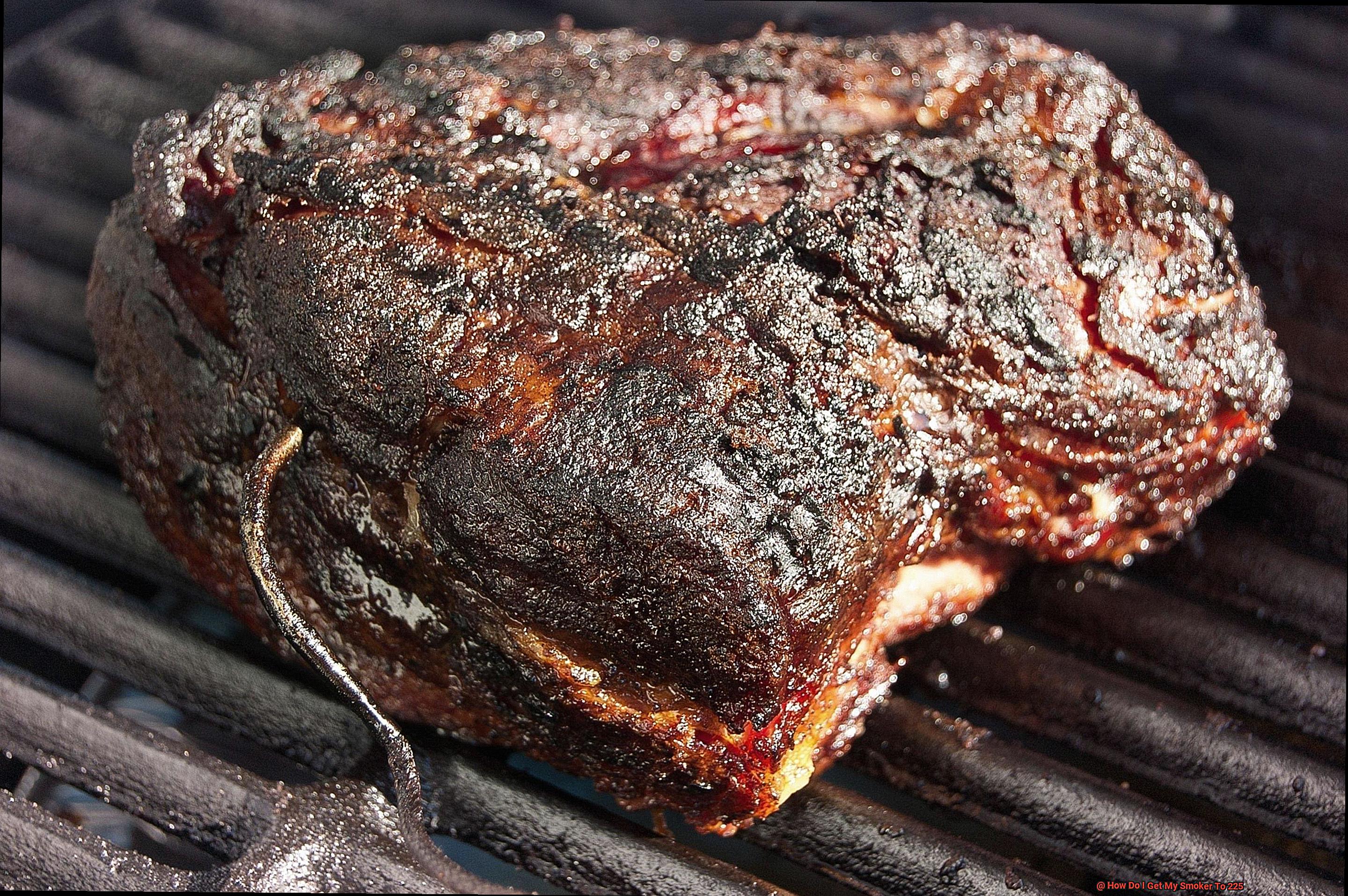
- Learning curve: Beginners may need some practice to master temperature control and charcoal management.
- Time-consuming: Charcoal smokers require regular monitoring and maintenance during the cooking process.
Electric Smokers:
Pros:
- Precise temperature control: Electric smokers offer easy-to-use temperature settings, making it simple to maintain a specific temperature like 225 degrees.
- Convenience: No fire management required; simply plug in and set your desired temperature.
Cons:
- Limited smoky flavor: Electric smokers may not produce as strong a smoky flavor compared to other types.
- Higher upfront cost: Electric smokers tend to be more expensive than charcoal options.
Offset Smokers:
Pros:
- Authentic smoky flavor: Offset smokers provide a traditional smoking experience with a distinct smoky flavor.
- Versatility: These smokers can also be used as charcoal grills for direct heat cooking.
Cons:
- Skill required: Achieving and maintaining a consistent temperature can be challenging, especially for beginners.
- Longer cooking time: Offset smokers often require longer cooking times due to indirect heat circulation.
Pellet Smokers:
Pros:
- Precise temperature control: Pellet smokers offer digital controls that allow you to set and maintain specific temperatures accurately.
- Consistent smoke production: These smokers automatically feed wood pellets into the firepot, ensuring a consistent level of smoke.
Cons:
- Higher cost: Pellet smokers tend to be more expensive than other types of smokers.
- Limited availability: Depending on your location, finding wood pellets for fuel may be more challenging.
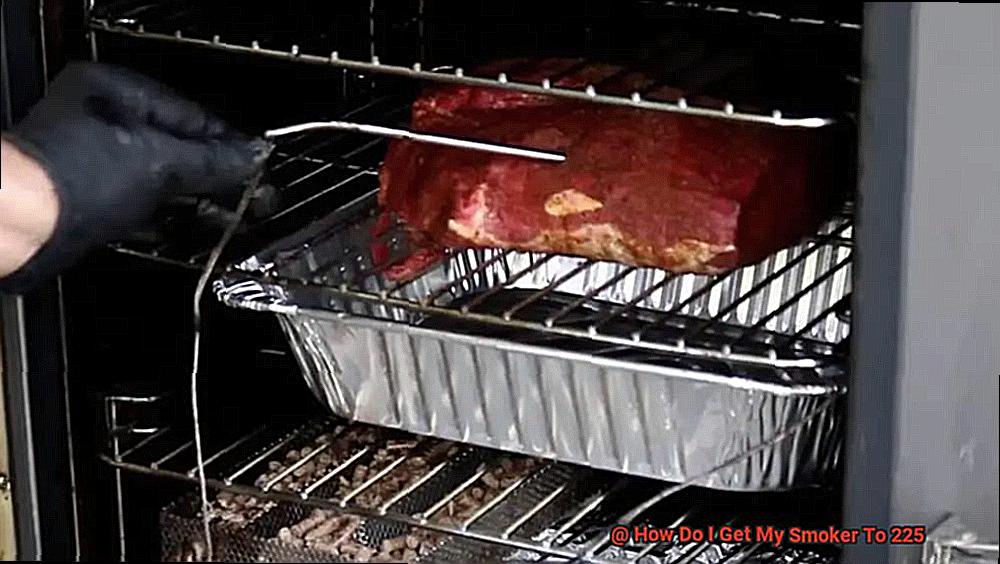
Gas Smokers:
Pros:
- Quick heating: Gas smokers heat up quickly, allowing for faster cooking times.
- Easy to use: Gas smokers are simple to operate and require minimal maintenance.
Cons:
- Difficulty maintaining low temperatures: Gas smokers may struggle to maintain temperatures as low as 225 degrees for extended periods.
- Limited smoke flavor: Gas smokers may produce less smoky flavor compared to other types.
When choosing a smoker, consider factors such as budget, desired level of control, and the amount of time you’re willing to dedicate to maintaining temperature. Read reviews and seek recommendations from experienced grillers to make an informed decision. Remember that practice and experimentation are key to perfecting your smoking skills.
Using the Right Amount of Charcoal
In our previous section, we explored the different types of smokers and how they can impact your smoking experience. Now, let’s delve into the crucial topic of using the right amount of charcoal to unlock that perfect smoky flavor you crave.
To start off, we highly recommend using a chimney starter. This nifty tool not only ensures an even distribution of heat but also eliminates the need for lighter fluid, which can taint the taste of your food. So, grab your chimney starter and let’s get grilling.
The amount of charcoal required depends on the size and type of smoker you’re using. As a general rule of thumb, aim for approximately 1 pound of charcoal per hour for every 25 degrees above the ambient temperature. For our desired temperature of 225 degrees Fahrenheit, this translates to around 4 pounds of charcoal.
Now that you have your charcoal ready, it’s time to arrange it in your smoker strategically. The key is to create a hot zone on one side and a cooler zone on the other. Why? Because this setup allows for indirect cooking and helps maintain a consistent temperature throughout the smoking process.
To take your smoked dishes to the next level, consider adding wood chunks or chips alongside the charcoal. Beforehand, make sure to soak the wood in water to prevent it from burning too quickly and producing excessive smoke. This infusion of smoky goodness will give your food a delightful aroma without overpowering its flavors.
Throughout the smoking process, it is crucial to monitor the temperature closely and make adjustments as needed. This may involve adding or removing charcoal to maintain that perfect 225 degrees Fahrenheit sweet spot.
Remember, each smoker is unique, so always consult your manufacturer’s instructions for tailored guidance specific to your model.
Adjusting Airflow to Regulate Temperature
Mastering the art of adjusting airflow is the key to achieving the perfect temperature in your smoker. Whether you’re smoking meats or creating mouthwatering delicacies, understanding how to control airflow is crucial for maintaining consistent heat and creating an ideal cooking environment.
Harnessing the Power of Airflow:
Airflow is the secret ingredient that keeps your smoker at the desired temperature. By adjusting the vents or dampers, you have control over the amount of oxygen that enters your smoker, which directly affects combustion and heat production.
Unleashing the Mastery of Airflow Control:
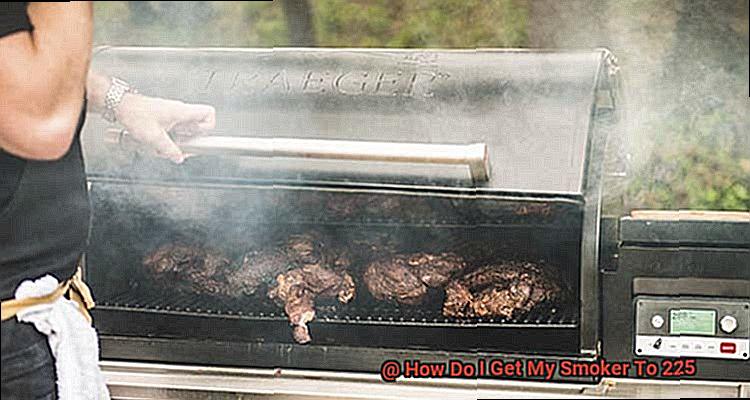
Different types of smokers require different methods for adjusting airflow. Offset smokers offer adjustable vents on the firebox and chimney, while bullet smokers have vents at both the bottom and top. Pellet smokers provide a digital control system for precise airflow adjustment.
Infusing Flavor with Perfect Smoke Production:
Properly adjusted airflow ensures an exquisite balance between smoke production and flavor infusion. By regulating the vents or dampers, you can control how much smoke circulates around your meat, ensuring it is infused with just the right amount of smoky goodness.
Tips for Airflow Management:
To maintain a steady temperature of 225°F, start by fully opening all vents during the initial heating phase to allow maximum oxygen flow. Once you reach your target temperature, make gradual adjustments to the vents until you achieve a stable temperature.
Avoiding Common Mistakes:
One common mistake is making frequent or drastic adjustments to the vents, which can cause temperature fluctuations. Instead, make small adjustments and give your smoker time to respond before making further changes.
Remember that external factors, such as weather conditions, can impact airflow regulation. Windy conditions may require you to adjust the vents differently to maintain your desired temperature.
Troubleshooting for Temperature Consistency:
If you find it challenging to maintain a consistent temperature, check for air leaks in your smoker and ensure all vents are properly closed or adjusted. Additionally, consider using a water pan to help stabilize the temperature.
Utilizing Different Types of Wood for Smoking
Imagine taking a bite into a perfectly smoked piece of meat and being transported to flavor paradise. Well, my young grill masters, the secret lies in the type of wood you use for smoking. Each type of wood has its own special flavor and aroma, like a secret ingredient that adds a touch of magic to your food.
When it comes to smoking meats, the type of wood you choose can make all the difference in creating that mouthwatering experience. The smoke from the wood penetrates the meat, infusing it with unique flavors and aromas.
Hickory, for example, is known for its strong and robust flavor, perfect for beef and pork. Mesquite, on the other hand, brings an intense and distinct taste, ideal for grilling mouthwatering briskets and ribs.
Applewood and cherry wood add sweetness to the party, making poultry and fish dance with delight. Oak, being a versatile wood, goes well with all types of meat, providing a medium smoky flavor that won’t overpower your taste buds.
The Wood Squad: Meet the Superstars of Smoking
Let’s meet the superstar lineup of wood for smoking. Each member of this wood squad brings its own unique character to the table. Hickory takes center stage with its bold and smoky flavor. It’s like the rock star of the group, commanding attention and adding depth to your smoked meats. Mesquite, on the other hand, is the wild child with its intense and distinct taste. It’s like the rebel in the group, bringing a bold and robust flavor to your grilling adventures.
Applewood and cherry wood are like the sweethearts of the squad, bringing a touch of sweetness to your smoked meats. They’re like the romantic duo, making poultry and fish fall in love with their delicate flavors. And last but not least, oak is the versatile one that goes well with all types of meat. It’s like the reliable friend who always has your back, providing a balanced and medium smoky flavor that won’t overpower your taste buds.
Matching Wood with Meat: A Flavorful Symphony
Choosing the right type of wood for your meat is like creating a symphony of flavors. Different meats have different tastes and textures, so it’s important to pair them with the right wood. Pork and beef team up with hickory for a bold and smoky experience. The strong and robust flavor of hickory complements the rich flavors of pork and beef, creating a harmonious combination that will leave your taste buds singing in delight.
Employing a Water Pan or Heat Deflector
Imagine a lazy summer afternoon, where the tantalizing aroma of smoked meat permeates the air, and the sizzle of perfection resonates from your grill. If you’re looking to elevate your grilling game, employing a water pan or heat deflector in your smoker can revolutionize your experience. Join us as we explore the benefits of these tools, how they create an even cooking environment, and enable you to regulate temperature like a seasoned pro.
The Water Pan: A Smoker’s Best Friend
Envision a humble shallow pan brimming with water, delicately perched above the heat source in your smoker. This unassuming water pan becomes your secret weapon, absorbing and radiating heat, ensuring a steady temperature inside the smoker. Let’s delve into why it’s an essential asset:
- Temperature Regulation: The water pan stabilizes the temperature, preventing drastic fluctuations that could leave you with overcooked or undercooked meat.
- Moisture Retention: Long smoking sessions can easily desiccate your meat, but fret not. The water pan infuses moisture into the cooking environment, preserving succulence and tenderness.
Heat Deflectors: Indirect Heat for Perfectly Cooked Meats
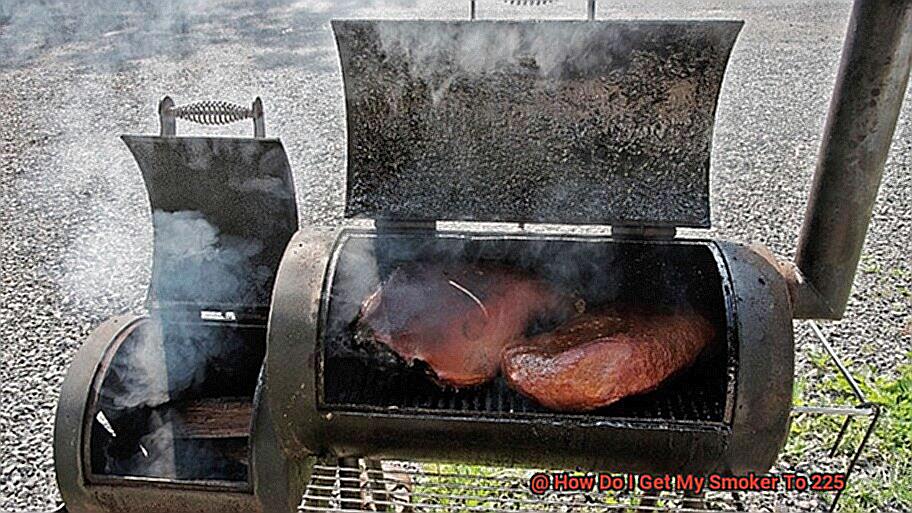
Sometimes, direct heat just doesn’t cut it. Enter heat deflectors – metallic or ceramic barriers interposed between the heat source and your food. Here’s why they deserve your attention:
- Even Cooking: Heat deflectors create an oasis of indirect heat, allowing for slow and uniform cooking. This proves especially advantageous for larger cuts of meat demanding extended cooking times.
- Temperature Control: By redirecting heat away from direct contact with the food, heat deflectors bestow upon you precise temperature control throughout the smoking process.
Achieving the Perfect Smoking Temperature
Both water pans and heat deflectors serve as effective tools for achieving and maintaining the ideal smoking temperature of 225 degrees Fahrenheit. This sweet spot ensures that your food cooks low and slow, yielding tender, flavorful bites.
Tips and Tricks for Success
To maximize the benefits of water pans and heat deflectors, bear these invaluable tips in mind:
- Monitor Water Levels: Regularly check the water level and replenish as needed to maintain optimal moisture in the pan.
- Proper Placement: Consult your smoker’s instructions or user manual to ensure accurate positioning of the water pan or heat deflector.
- Embrace Experimentation: Every smoker possesses its own unique characteristics, so fearlessly experiment with water levels or heat deflector positioning to discover what works best for you.
Monitoring the Temperature Throughout Cooking Process
If you’re ready to elevate your grilling game and become a true smoking master, then temperature monitoring is your secret weapon. In this blog post, we’ll explore why monitoring the temperature throughout the cooking process is essential for achieving mouthwatering results when using a smoker.
Slow and Steady for Flavorful Success:
Smokers work their magic by cooking food slowly at low temperatures, typically around 225 degrees Fahrenheit. This slow and steady approach allows flavors to develop, meat to tenderize, and juices to lock in, resulting in an explosion of taste with every bite.
The Thermometer: Your Trusted Sidekick:
To maintain that perfect temperature, you’ll need a reliable thermometer by your side. Choose from wireless wonders that allow remote monitoring or trusty probe thermometers that accurately track the meat’s internal temperature.
Placement: Where It Matters Most:
Where you place your thermometer inside the smoker can make or break your temperature readings. For vertical smokers, position it at the same level as the food being cooked. In horizontal offset smokers, place it near the cooking chamber’s grate level for precise results.
Steady as She Smokes:
Consistency is key when it comes to smoking. Temperature fluctuations can disrupt cooking times and leave you with unevenly cooked food. To maintain that steady 225-degree Fahrenheit temperature, regulate airflow by adjusting vents, dampers, or fuel sources.
Trust but Verify:
While some smokers have built-in temperature gauges, relying on a separate thermometer ensures more accurate readings. Built-in gauges can be unreliable or provide average temperatures instead of specific cooking area readings.
Tailoring Temperatures to Taste:
Different meats and recipes require different cooking temperatures and times. Some cuts or dishes may call for lower temperatures or longer cooking times. By monitoring the meat’s internal temperature with a probe thermometer, you’ll know precisely when it reaches the desired doneness.
Maintaining a Consistent 225-Degree Temperature
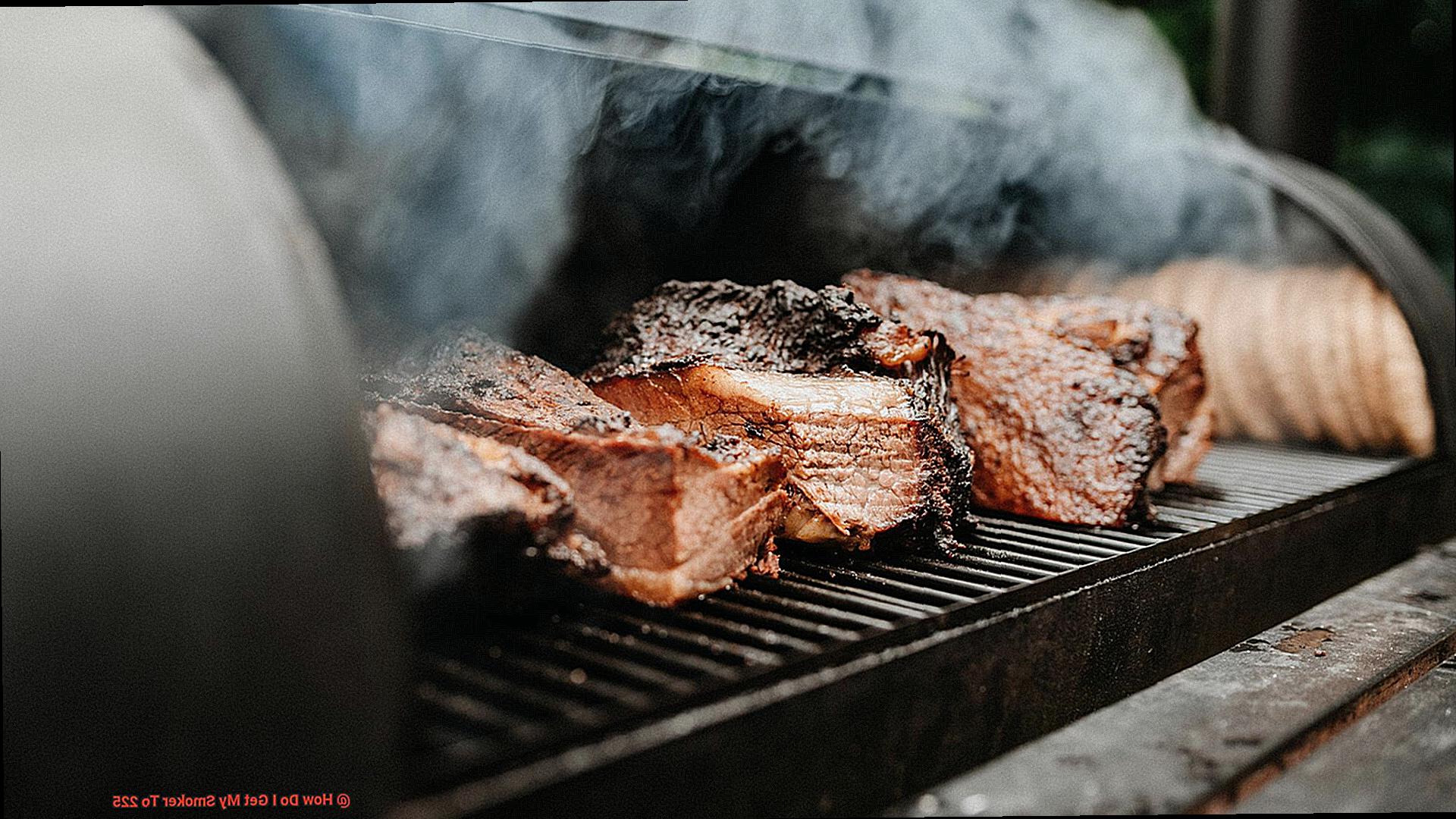
Achieving that tantalizing, fall-off-the-bone perfection hinges on one crucial element: maintaining a consistent 225-degree temperature in your smoker. Fear not, my fellow grill enthusiasts, because I am here to be your guiding light on the path to smoking greatness.
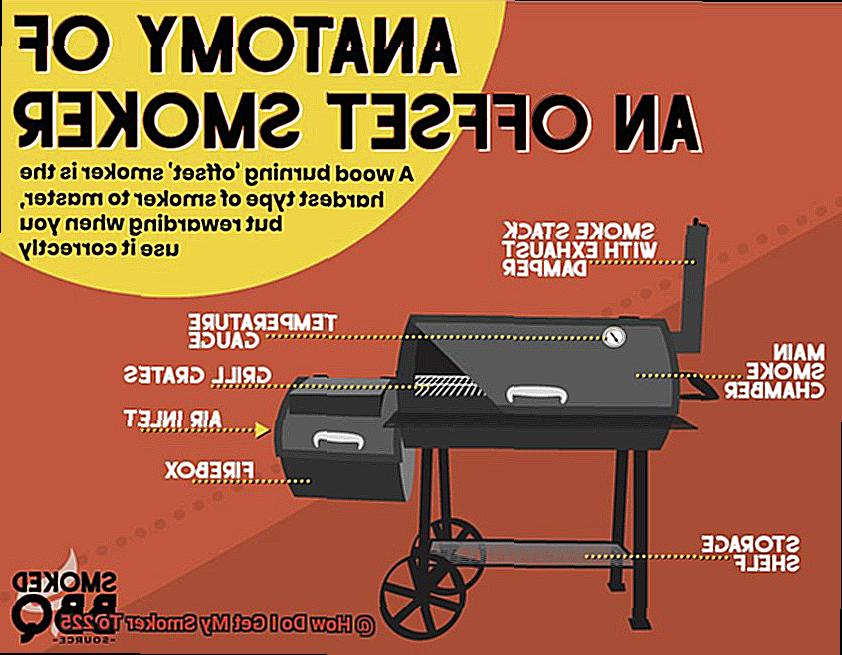
The first step on this journey is choosing the right fuel. Whether you prefer the smoky embrace of charcoal, the convenience of wood pellets, or the ease of gas, selecting the perfect fuel source is paramount. Each option has its own merits and drawbacks, so choose according to your personal taste and style. Once you’ve made your selection, it’s time to ignite the fire. Ensure that your grill is free from any remnants of past ash or debris, for this will guarantee optimal ventilation and efficient airflow.
Speaking of airflow, this is where you can truly fine-tune your temperature control. Most smokers are equipped with vents or dampers that grant you the power to adjust oxygen flow to the fire. Wider vent openings will raise the temperature, while partially closed vents will lower it. Experiment with different vent positions until you find that elusive sweet spot at 225 degrees.
Now let us delve into the realm of accuracy. While most smokers come equipped with built-in thermometers, their reliability can be questionable at best. To obtain precise temperature readings, invest in a high-quality digital thermometer complete with a probe. Place the probe near the food being cooked for an accurate reading of the cooking chamber’s temperature.
To maintain that consistent 225-degree temperature with even greater finesse, consider incorporating water pans or heat deflectors into your smoking arsenal. Water pans serve as heat sinks, absorbing excess warmth and releasing it slowly to regulate the overall temperature inside the smoker. Heat deflectors assist in distributing heat evenly throughout the cooking chamber, preventing troublesome hot spots that may cause temperature fluctuations.
Finally, must resist the temptation to incessantly open the smoker lid and check on your culinary creation. Each time you lift that lid, precious heat escapes, disrupting the cooking process. Have faith in your temperature monitoring equipment and only open the lid when necessary, such as when adding wood chips or assessing doneness.
Low and Slow Cooking Methods at 225 Degrees Fahrenheit
Look no further than the low and slow cooking method at 225 degrees Fahrenheit. This technique, popular in smoking and barbecue, unlocks the secrets to tender and mouthwatering results. In this article, we’ll explore the significance of temperature regulation and the use of a reliable thermometer when grilling with this method. So don your apron, fire up your smoker, and let’s dive in.
Regulating Temperature:
Consistency is key in low and slow cooking. A steady 225 degrees Fahrenheit ensures evenly cooked meat that is juicy and succulent. Proper airflow and fuel source management are vital factors in achieving this ideal temperature. Familiarize yourself with your specific smoker model to master the art of temperature regulation.
Reliable Thermometer:
A trustworthy digital thermometer is your grilling ally for low and slow cooking. It lets you monitor the internal meat temperature accurately throughout the process. External factors like weather conditions or fuel level changes can influence the smoker’s temperature. But armed with a reliable thermometer, adjustments can be made to maintain that perfect 225 degrees Fahrenheit.
Advantages of Low and Slow Cooking:
- Tender and Flavorful Results: Connective tissues break down, fat renders, resulting in moist meat bursting with flavor.
- Ideal for Tough Cuts: Brisket or pork shoulder transforms into succulent masterpieces with extended cooking times.
- Versatility: Ribs, chicken, even vegetables benefit from low and slow cooking. Deep flavors infuse while moisture is retained.
Patience is Key:
Perfection takes time. Allow several hours, or even overnight for larger cuts of meat to reach their full potential. Resist the temptation to rush by increasing the heat or frequently opening the smoker lid. Low and slow cooking is a labor of love that rewards those who practice patience.
0Wo9gK1MP9c” >
Conclusion
To achieve the desired temperature of 225 degrees on your smoker, there are a few key steps you can take.
Firstly, ensure that you have a reliable thermometer to accurately measure the heat. Next, carefully control the airflow by adjusting the dampers and vents on your smoker.
This will help regulate the amount of oxygen entering the firebox and maintain a consistent temperature. Additionally, using high-quality charcoal or wood pellets can provide a steady source of heat.
Finally, be patient and avoid constantly opening the lid, as this can cause fluctuations in temperature.

